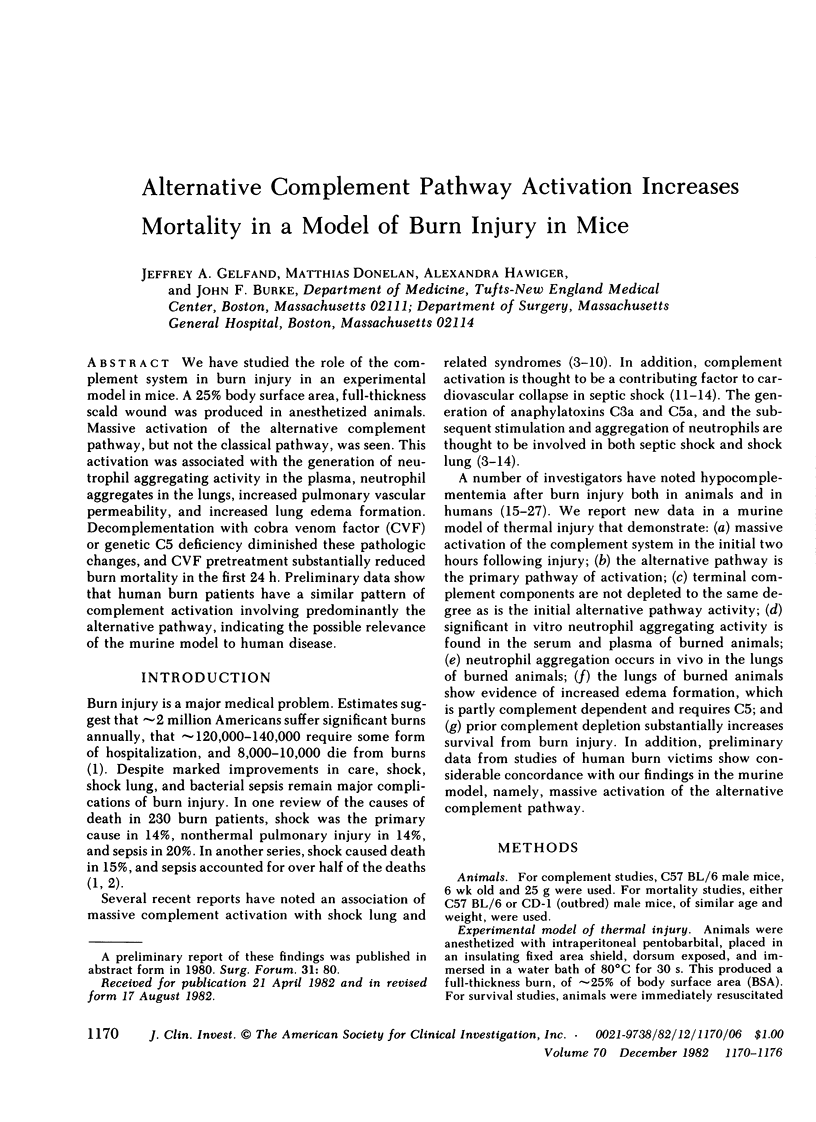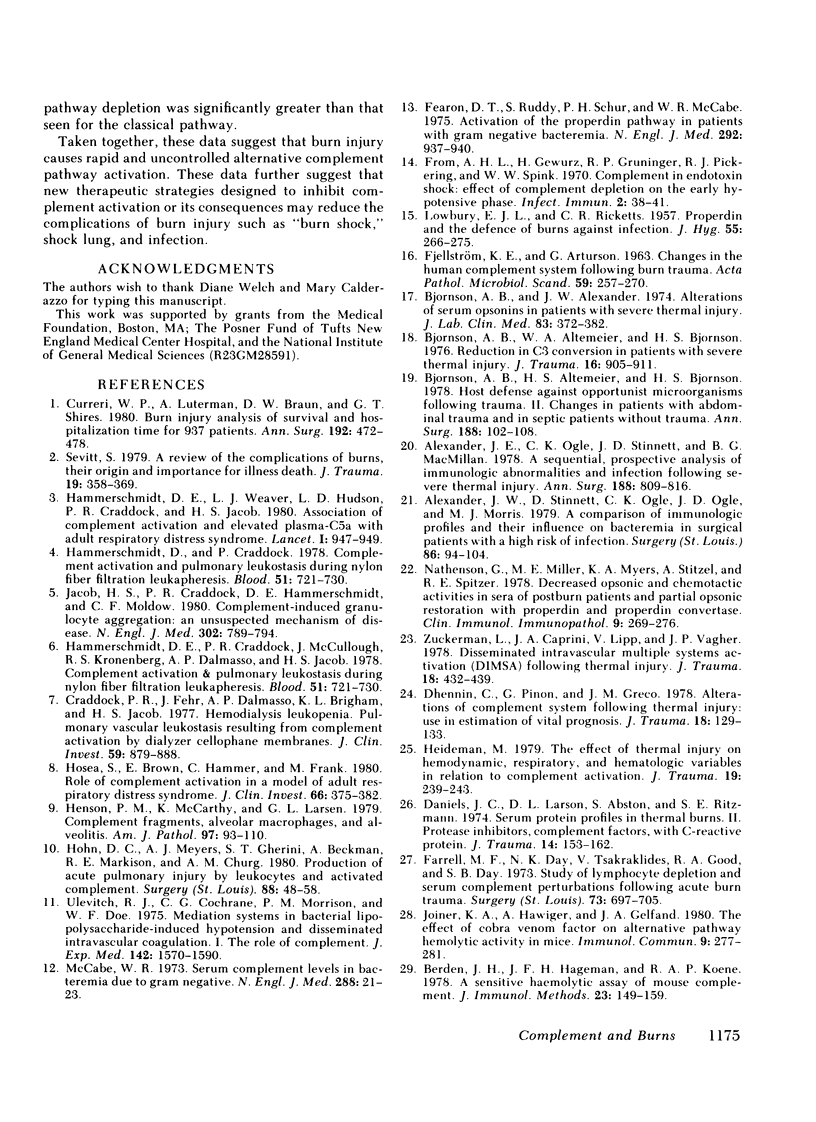Abstract
We have studied the role of the complement system in burn injury in an experimental model in mice. A 25% body surface area, full-thickness scald wound was produced in anesthetized animals. Massive activation of the alternative complement pathway, but not the classical pathway, was seen. This activation was associated with the generation of neutrophil aggregating activity in the plasma, neutrophil aggregates in the lungs, increased pulmonary vascular permeability, and increased lung edema formation. Decomplementation with cobra venom factor (CVF) or genetic C5 deficiency diminished these pathologic changes, and CVF pretreatment substantially reduced burn mortality in the first 24 h. Preliminary data show that human burn patients have a similar pattern of complement activation involving predominantly the alternative pathway, indicating the possible relevance of the murine model to human disease.
Full text
PDF






Images in this article
Selected References
These references are in PubMed. This may not be the complete list of references from this article.
- Alexander J. W., Ogle C. K., Stinnett J. D., Macmillan B. G. A sequential, prospective analysis of immunologic abnormalities and infection following severe thermal injury. Ann Surg. 1978 Dec;188(6):809–816. doi: 10.1097/00000658-197812000-00016. [DOI] [PMC free article] [PubMed] [Google Scholar]
- Alexander J. W., Stinnett J. D., Ogle C. K., Ogle J. D., Morris M. J. A comparison of immunologic profiles and their influence on bacteremia in surgical patients with a high risk of infection. Surgery. 1979 Jul;86(1):94–104. [PubMed] [Google Scholar]
- Atkinson J. P., McGinnis K., Shreffler D. Development and characterization of a hemolytic assay for mouse C4. J Immunol Methods. 1980;33(4):351–368. doi: 10.1016/0022-1759(80)90005-8. [DOI] [PubMed] [Google Scholar]
- Baker P. J., Croker B. P., Osofsky S. G. Interactions of human, cultured kidney cells with the complement system. Kidney Int. 1981 Oct;20(4):437–441. doi: 10.1038/ki.1981.159. [DOI] [PubMed] [Google Scholar]
- Baker P. J., Osofsky S. G. Activation of human complement by heat-killed, human kidney cells grown in cell culture. J Immunol. 1980 Jan;124(1):81–86. [PubMed] [Google Scholar]
- Berden J. H., Hagemann J. F., Koene R. A. A sensitive haemolytic assay of mouse complement. J Immunol Methods. 1978;23(1-2):149–159. doi: 10.1016/0022-1759(78)90118-7. [DOI] [PubMed] [Google Scholar]
- Bjornson A. B., Alexander J. W. Alterations of serum opsonins in patients with severe thermal injury. J Lab Clin Med. 1974 Mar;83(3):372–382. [PubMed] [Google Scholar]
- Bjornson A. B., Altemeier W. A., Bjornson H. S. Host defense against opportunist microorganisms following trauma. II. Changes in complement and immunoglobulins in patients with abdominal trauma and in septic patients without trauma. Ann Surg. 1978 Jul;188(1):102–108. doi: 10.1097/00000658-197807000-00017. [DOI] [PMC free article] [PubMed] [Google Scholar]
- Bjornson A. B., Altemeier W. A., Bjornson H. S. Reduction in C3 conversion in patients with severe thermal injury. J Trauma. 1976 Nov;16(11):905–911. doi: 10.1097/00005373-197611000-00009. [DOI] [PubMed] [Google Scholar]
- Brown E. J., Hosea S. W., Hammer C. H., Burch C. G., Frank M. M. A quantitative analysis of the interactions of antipneumococcal antibody and complement in experimental pneumococcal bacteremia. J Clin Invest. 1982 Jan;69(1):85–98. doi: 10.1172/JCI110444. [DOI] [PMC free article] [PubMed] [Google Scholar]
- Craddock P. R., Fehr J., Dalmasso A. P., Brighan K. L., Jacob H. S. Hemodialysis leukopenia. Pulmonary vascular leukostasis resulting from complement activation by dialyzer cellophane membranes. J Clin Invest. 1977 May;59(5):879–888. doi: 10.1172/JCI108710. [DOI] [PMC free article] [PubMed] [Google Scholar]
- Craddock P. R., Hammerschmidt D., White J. G., Dalmosso A. P., Jacob H. S. Complement (C5-a)-induced granulocyte aggregation in vitro. A possible mechanism of complement-mediated leukostasis and leukopenia. J Clin Invest. 1977 Jul;60(1):260–264. doi: 10.1172/JCI108763. [DOI] [PMC free article] [PubMed] [Google Scholar]
- Craddock P. R., White J. G., Jacob H. S. Potentiation of complement (C5a)-induced granulocyte aggregation by cytochalasin B. J Lab Clin Med. 1978 Mar;91(3):490–499. [PubMed] [Google Scholar]
- Curreri P. W., Luterman A., Braun D. W., Jr, Shires G. T. Burn injury. Analysis of survival and hospitalization time for 937 patients. Ann Surg. 1980;192(4):472–478. doi: 10.1097/00000658-198010000-00006. [DOI] [PMC free article] [PubMed] [Google Scholar]
- Daniels J. C., Larson D. L., Abston S., Ritzmann S. E. Serum protein profiles in thermal burns. II. Protease inhibitors, complement factors, and c-reactive protein. J Trauma. 1974 Feb;14(2):153–162. doi: 10.1097/00005373-197402000-00007. [DOI] [PubMed] [Google Scholar]
- Dhennin Ch, Pinon G., Greco J. M. Alterations of complement system following thermal injury: use in estimation of vital prognosis. J Trauma. 1978 Feb;18(2):129–133. doi: 10.1097/00005373-197802000-00010. [DOI] [PubMed] [Google Scholar]
- FJELLSTROEM K. E., ARTURSON G. CHANGES IN THE HUMAN COMPLEMENT SYSTEM FOLLOWING BURN TRAUMA. Acta Pathol Microbiol Scand. 1963;59:257–270. doi: 10.1111/j.1699-0463.1963.tb01796.x. [DOI] [PubMed] [Google Scholar]
- Farrell M. F., Day N. K., Tsakraklides V., Good R. A., Day S. B. Study of lymphocyte depletion and serum complement perturbations following acute burn trauma. Surgery. 1973 May;73(5):697–705. [PubMed] [Google Scholar]
- Fearon D. T., Austen K. F. Activation of the alternative complement pathway due to resistance of zymosan-bound amplification convertase to endogenous regulatory mechanisms. Proc Natl Acad Sci U S A. 1977 Apr;74(4):1683–1687. doi: 10.1073/pnas.74.4.1683. [DOI] [PMC free article] [PubMed] [Google Scholar]
- Fearon D. T., Austen K. F. Activation of the alternative complement pathway with rabbit erythrocytes by circumvention of the regulatory action of endogenous control proteins. J Exp Med. 1977 Jul 1;146(1):22–33. doi: 10.1084/jem.146.1.22. [DOI] [PMC free article] [PubMed] [Google Scholar]
- Fearon D. T., Austen K. F. Properdin: binding to C3b and stabilization of the C3b-dependent C3 convertase. J Exp Med. 1975 Oct 1;142(4):856–863. doi: 10.1084/jem.142.4.856. [DOI] [PMC free article] [PubMed] [Google Scholar]
- Fearon D. T. Regulation by membrane sialic acid of beta1H-dependent decay-dissociation of amplification C3 convertase of the alternative complement pathway. Proc Natl Acad Sci U S A. 1978 Apr;75(4):1971–1975. doi: 10.1073/pnas.75.4.1971. [DOI] [PMC free article] [PubMed] [Google Scholar]
- Fearon D. T., Ruddy S., Schur P. H., McCabe W. R. Activation of the properdin pathway of complement in patients with gram-negative of bacteremia. N Engl J Med. 1975 May 1;292(18):937–940. doi: 10.1056/NEJM197505012921802. [DOI] [PubMed] [Google Scholar]
- Frank M. M., Gelfand J. A., Atkinson J. P. Hereditary angioedema: the clinical syndrome and its management. Ann Intern Med. 1976 May;84(5):580–593. doi: 10.7326/0003-4819-84-5-580. [DOI] [PubMed] [Google Scholar]
- From A. H., Gewurz H., Gruninger R. P., Pickering R. J., Spink W. W. Complement in endotoxin shock: effect of complement depletion on the early hypotensive phase. Infect Immun. 1970 Jul;2(1):38–41. doi: 10.1128/iai.2.1.38-41.1970. [DOI] [PMC free article] [PubMed] [Google Scholar]
- Hammerschmidt D. E., Bowers T. K., Lammi-Keefe C. J., Jacob H. S., Craddock P. R. Granulocyte aggregometry: a sensitive technique for the detection of C5a and complement activation. Blood. 1980 Jun;55(6):898–902. [PubMed] [Google Scholar]
- Hammerschmidt D. E., Craddock P. R., McCullough F., Kronenberg R. S., Dalmasso A. P., Jacob H. S. Complement activation and pulmonary leukotasis during nylon fiber filtration leukapheresis. Blood. 1978 Apr;51(4):721–730. [PubMed] [Google Scholar]
- Hammerschmidt D. E., Craddock P. R., McCullough F., Kronenberg R. S., Dalmasso A. P., Jacob H. S. Complement activation and pulmonary leukotasis during nylon fiber filtration leukapheresis. Blood. 1978 Apr;51(4):721–730. [PubMed] [Google Scholar]
- Hammerschmidt D. E., Weaver L. J., Hudson L. D., Craddock P. R., Jacob H. S. Association of complement activation and elevated plasma-C5a with adult respiratory distress syndrome. Pathophysiological relevance and possible prognostic value. Lancet. 1980 May 3;1(8175):947–949. doi: 10.1016/s0140-6736(80)91403-8. [DOI] [PubMed] [Google Scholar]
- Heideman M. Complement activation in vitro induced by endotoxin and injured tissue. J Surg Res. 1979 Jun;26(6):670–673. doi: 10.1016/0022-4804(79)90063-5. [DOI] [PubMed] [Google Scholar]
- Heideman M. The effect of thermal injury on hemodynamic, respiratory, and hematologic variables in relation to complement activation. J Trauma. 1979 Apr;19(4):239–247. doi: 10.1097/00005373-197904000-00004. [DOI] [PubMed] [Google Scholar]
- Hohn D. C., Meyers A. J., Gherini S. T., Beckmann A., Markison R. E., Churg A. M. Production of acute pulmonary injury by leukocytes and activated complement. Surgery. 1980 Jul;88(1):48–58. [PubMed] [Google Scholar]
- Hosea S., Brown E., Hammer C., Frank M. Role of complement activation in a model of adult respiratory distress syndrome. J Clin Invest. 1980 Aug;66(2):375–382. doi: 10.1172/JCI109866. [DOI] [PMC free article] [PubMed] [Google Scholar]
- Jacob H. S., Craddock P. R., Hammerschmidt D. E., Moldow C. F. Complement-induced granulocyte aggregation: an unsuspected mechanism of disease. N Engl J Med. 1980 Apr 3;302(14):789–794. doi: 10.1056/NEJM198004033021407. [DOI] [PubMed] [Google Scholar]
- Joiner K. A., Hawiger A., Gelfand J. A. The effect of cobra venom factor on alternative pathway hemolytic activity in mice. Immunol Commun. 1980;9(3):277–281. doi: 10.3109/08820138009066000. [DOI] [PubMed] [Google Scholar]
- Joiner K. A., Shahon R., Gelfand J. A. A sensitive microassay for the murine alternative complement pathway. J Immunol Methods. 1979;31(3-4):283–290. doi: 10.1016/0022-1759(79)90141-8. [DOI] [PubMed] [Google Scholar]
- LOWBURY E. J., RICKETTS C. R. Properdin and the defence of burns against infection. J Hyg (Lond) 1957 Jun;55(2):266–275. doi: 10.1017/s0022172400037153. [DOI] [PMC free article] [PubMed] [Google Scholar]
- McCabe W. R. Serum complement levels in bacteremia due to gram-negative organisms. N Engl J Med. 1973 Jan 4;288(1):21–23. doi: 10.1056/NEJM197301042880105. [DOI] [PubMed] [Google Scholar]
- Nathenson G., Miller M. E., Myers K. A., Stitzel A., Spitzers R. E. Decreased opsonic and chemotactic activities in sera of postburn patients and partial opsonic restoration with properdin and properdin convertase. Clin Immunol Immunopathol. 1978 Mar;9(3):269–276. doi: 10.1016/0090-1229(78)90098-3. [DOI] [PubMed] [Google Scholar]
- Sandberg A. L., Osler A. G. Dual pathways of complement interaction with guinea pig immunoglobulins. J Immunol. 1971 Nov;107(5):1268–1273. [PubMed] [Google Scholar]
- Sevitt S. A review of the complications of burns, their origin and importance for illness and death. J Trauma. 1979 May;19(5):358–369. doi: 10.1097/00005373-197905000-00010. [DOI] [PubMed] [Google Scholar]
- Sim R. B., Sim E. Autolytic fragmentation of complement components C3 and C4 under denaturing conditions, a property shared with alpha 2-macroglobulin. Biochem J. 1981 Jan 1;193(1):129–141. doi: 10.1042/bj1930129. [DOI] [PMC free article] [PubMed] [Google Scholar]
- Ulevitch R. J., Cochrane C. G., Henson P. M., Morrison D. C., Doe W. F. Mediation systems in bacterial lipopolysaccharide-induced hypotension and disseminated intravascular coagulation. I. The role of complement. J Exp Med. 1975 Dec 1;142(6):1570–1590. doi: 10.1084/jem.142.6.1570. [DOI] [PMC free article] [PubMed] [Google Scholar]
- Zuckerman L., Caprini J. A., Lipp V., Vagher J. P. Disseminated intravascular multiple systems activation (DIMSA) following thermal injury. J Trauma. 1978 Jun;18(6):432–439. doi: 10.1097/00005373-197806000-00008. [DOI] [PubMed] [Google Scholar]




